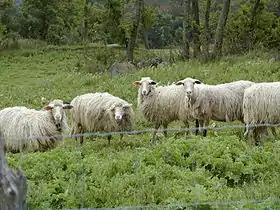 Appenninica sheep in Tuscany | |
| Conservation status | FAO (2007): not at risk[1] |
|---|---|
| Country of origin | Italy |
| Distribution | |
| Standard | MIPAAF |
| Use | meat |
| Traits | |
| Weight | |
| Height | |
| Skin color | pinkish |
| Wool color | white |
| Face color | white |
| Horn status | hornless in both sexes |
| |
The Appenninica is a modern breed of sheep from the central Apennine mountains of Italy.[3] It is raised principally in Tuscany and Umbria, but also in Abruzzo, Emilia–Romagna, Lazio, the Marche[4] and Campania.[5] The breed was created in the 1970s by cross-breeding and subsequent selection of local breeds such as the Bariscianese, the Casentinese, the Chietina Varzese, the Pagliarola, the Perugina del piano, the Pomarancina, the Senese delle Creti and the Vissana[6] with Bergamasca rams and with the French Ile-de-France and Berrichon du Cher, with the aim of increasing the meat yield. The breed was recognised in 1980[4] and a herdbook established in 1981.[7] Although this is a medium-coarse wool breed, it is raised primarily for meat.[4]
It has been used in the development of the Laticauda breed in the Campanian Apennines.[5]
Characteristics
The Appenninica is hornless (polled) in both sexes; the ears are carried horizontally. The average weight for mature rams is 78 kg (170 lb); average height at the withers is 77 cm (30 in) and average length 79 cm (31 in).[2] When mature, ewes weigh on average 56 kg, are 69 cm at the withers and are 73 cm long.[2] Rams yield about 2.5 kg (5.5 lb) of wool while ewes provide 1.5 kg.[4] The wool has a diameter of 30 to 35 micrometres.
The breed is well adapted to the terrain of the Apennine Mountains, Emilia and Abruzzo regions of Italy. It is one of the seventeen autochthonous Italian sheep breeds for which a genealogical herdbook is kept by the Associazione Nazionale della Pastorizia, the Italian national association of sheep-breeders.[3] From 1993 to 2007, the population of the Appenninica declined from greater than 160,000 to 3438.[7] In 2013 total numbers for the breed were 9791.[8]
References
- ↑ Barbara Rischkowsky, D. Pilling (eds.) (2007). List of breeds documented in the Global Databank for Animal Genetic Resources, annex to The State of the World's Animal Genetic Resources for Food and Agriculture. Rome: Food and Agriculture Organization of the United Nations. ISBN 9789251057629. Accessed May 2014.
- 1 2 3 4 5 6 Caratteri tipici e indirizzi di miglioramento della razza Appenninica (in Italian). Ministero delle Politiche Agricole, Alimentari e Forestali. Accessed May 2014.
- 1 2 Le razze ovine e caprine in Italia (in Italian). Associazione Nazionale della Pastorizia: Ufficio centrale libri genealogici e registri anagrafici razze ovine e caprine. p. 17. Accessed September 2013.
- 1 2 3 4 Daniele Bigi, Alessio Zanon (2008). Atlante delle razze autoctone: Bovini, equini, ovicaprini, suini allevati in Italia (in Italian). Milan: Edagricole. ISBN 9788850652594. p. 182–183.
- 1 2 Maiorano, G (2016). "Effects of intramuscular vitamin E multiple injection on quality, oxidative stability and consumer acceptability of meat from Laticauda lambs fed under natural rearing conditions". Small Ruminant Research. 139: 52–59. doi:10.1016/j.smallrumres.2016.05.004.
- ↑ Camilli, Francesca (2015). "A Preliminary Characterization of Wools from Italian Native Sheep Breeds: Opportunities for New Productions and the Development of Rural Areas". Journal of Natural Fibers. 12 (3): 265–275. doi:10.1080/15440478.2014.920287. S2CID 109758833 – via Taylor & Francis Online.
- 1 2 Breed data sheet: Appenninica/Italy. Domestic Animal Diversity Information System of the Food and Agriculture Organization of the United Nations. Accessed September 2013.
- ↑ Consistenze Provinciali della Razza 26 APPENNINICA Anno 2013 (in Italian). Associazione Nazionale della Pastorizia: Banca dati. Accessed September 2013.
Further reading
- R. Bozzi, P. Degl'Innocenti, P. Rivera Diaz, L. Nardi, A. Crovetti, C. Sargentini, A. Giorgetti (July 2009). Genetic characterization and breed assignment in five Italian sheep breeds using microsatellite markers. Small Ruminant Research 85 (1): 50–57. (Abstract; (subscription required) for full article).
- Emiliano Lasagna, Vincenzo Landi, Matteo Bianchi, Amparo Martínez Martínez, Francesca Maria Sarti (2009). Genetic characterization of Appenninica sheep breed by microsatellites. Italian Journal of Animal Science 8 (2s) (Proceedings of the 18th ASPA Congress, Palermo, 9–12 June 2009): 96–98.
- G. Filippini, F. Aloisio, F. Cecchi, M. Biagetti, F. Macchioni, R. Ciampolini, G. Venditti, E. Ciani, E. Mazzanti, C. Sebastiani and D. Cianci (2006). An investigation on the genetic resistance to Parasitical Fauna in Appenninica sheep breed. Proceedings of the 8th World Congress on Genetics Applied to Livestock Production, Belo Horizonte, Minas Gerais, Brazil, 13–18 August 2006: 38–41.
- F. Cecchi, R. Ciampolini, F. Macchioni, M. Biagetti, E. Ciani, G. Filippini, E. Mazzanti, M. Tancredi, P. Papa, and D. Deni (2006). The Genetic resistance to Coccidia in Appenninica sheep. Proceedings of the 8th World Congress on Genetics Applied to Livestock Production, Belo Horizonte, Minas Gerais, Brazil, 13–18 August 2006: 162–165.
- Lancioni H, Di Lorenzo P, Ceccobelli S, Perego UA, Miglio A, Landi V, Antognoni MT, Sarti FM, Lasagna E, Achilli A. (2013 ). Phylogenetic Relationships of Three Italian Merino-Derived Sheep Breeds Evaluated through a Complete Mitogenome Analysis. PLOS One. 8 (9): e73712. doi: 10.1371/journal.pone.0073712.